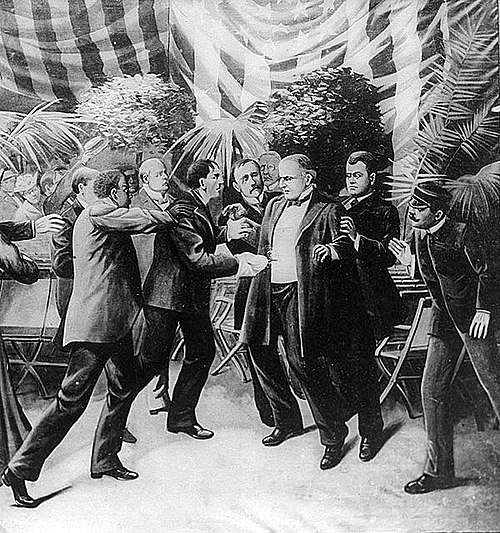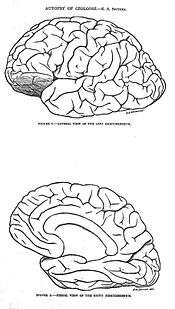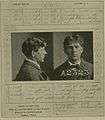Leon Czolgosz
| Leon Czolgosz | |
|---|---|
 Leon Czolgosz in 1900 | |
| Born |
Leon Frank Czolgosz May 5, 1873[1] Alpena, Michigan, U.S. |
| Died |
October 29, 1901 (aged 28) Auburn, New York, U.S. |
| Cause of death | Electrocution (executed via electric chair) |
| Occupation | Steel worker |
| Criminal charge | First-degree murder |
| Criminal penalty | Death by electrocution |
| Criminal status | Executed by electric chair |
| Parent(s) |
Paul Czolgosz[2] Mary Nowak |
| Motive | To advance anarchism |
| Conviction(s) | Assassination of William McKinley |
Leon Frank Czolgosz (Polish pronunciation: [ˈt͡ʂɔwɡɔʂ]; May 5, 1873 – October 29, 1901) was a Polish-American anarchist and former steel worker who assassinated U.S. President William McKinley in September 1901. Czolgosz was executed seven weeks later.
Early life
Czolgosz was born in Alpena, Michigan,[3][4][5] on May 5, 1873.[lower-alpha 1] He was one of eight children[7] born to Polish American family of Paul Czolgosz and his wife Mary Nowak. The Czolgosz family moved to Detroit when Leon was five.[lower-alpha 2] When he was 10 years old, while living in Posen, Michigan, Czolgosz's mother died six weeks after giving birth to his sister, Victoria.[9] In his mid-teens, he worked in a glass factory in Natrona, Pennsylvania.[10][11] By age seventeen he found employment at the Cleveland Rolling Mill Company.[12]
After the economic crash of 1893, when the factory closed for some time and looked to reduce wages, the workers went on strike, putting Leon and his brothers out of work. With great economic and social turmoil around him, Czolgosz found little comfort in the Catholic Church and other immigrant institutions, and sought others who shared his concerns regarding injustice. He joined a moderate workingman's socialist club, the Golden Eagle Society, and eventually a more radical socialist group known as the Sila Club where he became interested in anarchism.[13][14]
Interest in anarchism
In 1898, after witnessing a series of similar strikes (many ending in violence), and perhaps ill from a respiratory disease, Czolgosz went to live with his father who had bought a fifty-five acre farm the year before in Warrensville, Ohio.[15][16] He did little to assist in the running of the farm and was constantly at odds with his stepmother and with his family's Roman Catholic beliefs. It was later recounted that throughout his life he had never shown any interest in friendship or romantic relationships and was bullied during his childhood by peers.[17]
He became a recluse.[18] He was impressed after hearing a speech by the political radical Emma Goldman, whom he met for the first time during one of her lectures in Cleveland in May 1901. After the lecture, Czolgosz approached the speakers' platform and asked for reading recommendations. On the afternoon of July 12, 1901, he visited her at the home of Abraham Isaak, publisher of the newspaper Free Society, in Chicago and introduced himself as Fred Nieman (nobody),[lower-alpha 3] but Goldman was on her way to the train station. He only had enough time to explain to her about his disappointment in Cleveland's socialists, and for Goldman to introduce him to her anarchist friends who were at the train station.[20] She later wrote a piece in defense of Czolgosz.[21]
In the weeks that followed, his social awkwardness, his evasiveness, and his blunt inquiries about secret societies around Isaak and another anarchist, Emil Schilling, caused the radical Free Society newspaper to issue a warning pertaining to Czolgosz, on September 1, reading:[6]
ATTENTION! The attention of the comrades is called to another spy. He is well dressed, of medium height, rather narrow shoulders, blond and about 25 years of age. Up to the present he has made his appearance in Chicago and Cleveland. In the former place he remained but a short time, while in Cleveland he disappeared when the comrades had confirmed themselves of his identity and were on the point of exposing him. His demeanor is of the usual sort, pretending to be greatly interested in the cause, asking for names or soliciting aid for acts of contemplated violence. If this same individual makes his appearance elsewhere the comrades are warned in advance, and can act accordingly.
Czolgosz believed there was a great injustice in American society, an inequality which allowed the wealthy to enrich themselves by exploiting the poor. He concluded that the reason for this was the structure of government itself. Then he learned of a European crime which changed his life: On July 29, 1900, King Umberto I of Italy had been shot dead by anarchist Gaetano Bresci. Bresci told the press that he had decided to take matters into his own hands for the sake of the common man.[22]
New York City police lieutenant Joseph Petrosino believed that the same Italian-based anarchist group suspected of responsibility for King Umberto's death was also targeting President McKinley, but his warnings were ignored.[23]
Assassination of President McKinley
.jpg)


On August 31, 1901, Czolgosz traveled to Buffalo, New York, the site of the Pan-American Exposition, where he rented a room in Nowak's Hotel at 1078 Broadway.[24]
On September 6, Czolgosz went to the exposition armed with a concealed .32 caliber Iver Johnson "Safety Automatic" revolver[25][26] he had purchased four days earlier.[27] He approached McKinley, who had been standing in a receiving line inside the Temple of Music, greeting the public for ten minutes. At 4:07 P.M., Czolgosz reached the front of the line. McKinley extended his hand. Czolgosz slapped it aside and shot the President in the abdomen twice, at point blank range: the first bullet ricocheted off a coat button and lodged in McKinley's jacket; the other seriously wounded him in his stomach. President McKinley died eight days later on September 14 of an infection which had spread from the wound.
Members of the crowd immediately attacked Czolgosz, as McKinley slumped backward. The President said, "Go easy on him, boys."[28][29] The police struggled to keep the crowd off of Czolgosz.[30] He was held in a cell at Buffalo's 13th Precinct house at 346 Austin Street until he was moved to police headquarters.
Trial and execution

After McKinley's death, newly inaugurated President Theodore Roosevelt declared, "When compared with the suppression of anarchy, every other question sinks into insignificance."[31]
On September 13, the day before McKinley succumbed to his wounds, Czolgosz was taken from the police headquarters, which were undergoing repairs, and transferred to the Erie County Women's Penitentiary. On September 16, he was brought to the Erie County Jail ahead of being arraigned before County Judge Emery. After the arraignment, Czolgosz was transferred to Auburn State Prison.[32]
A grand jury indicted Czolgosz on September 16 with one count of first-degree murder. Throughout his incarceration, Czolgosz spoke freely with his guards, but he refused every interaction with Robert C. Titus and Loran L. Lewis, the prominent judges-turned-attorneys assigned to defend him, and with the expert psychiatrist sent to test his sanity.[33]
The case was prosecuted by the Erie County District Attorney, Thomas Penney, and assistant D.A. Frederick Haller, whose performance was described as "flawless".[lower-alpha 4] Although Czolgosz answered that he was pleading "Guilty", presiding Judge Truman C. White overruled him and entered a "Not Guilty" plea on his behalf.[34]
Even had the jury believed the defense that Czolgosz was insane, by claiming that no sane man would have shot and killed the president in such a public and blatant manner, knowing he would be caught, there was still the legal definition of insanity to be overcome. Under New York law, Czolgosz was legally insane only if he was unable to understand what he was doing.[35]
| Wikisource has a 1901 newspaper article related to the execution: "Buffalo Men at the Execution.: |
His last words were: "I killed the President because he was the enemy of the good people – the good working people. I am not sorry for my crime. I am sorry I could not see my father."[36] Czolgosz was electrocuted by three jolts, each of 1800 volts, in Auburn Prison on October 29, 1901, 45 days after his victim's death. He was pronounced dead at 07:14.[37]
Leon Czolgosz's brother, Waldek, and his brother-in-law, Frank Bandowski, were in attendance at the execution. When Waldek asked the warden for his brother's body to be taken for proper burial, he was informed that he "would never be able to take it away" and that crowds of people would mob him.[38]
Czolgosz was autopsied by John E. Gerin;[lower-alpha 5] his brain was autopsied by Edward Anthony Spitzka. The autopsy showed his teeth were normal but in poor condition; likewise the external genitals were normal although cicatrices were present—the result of chancroids. The autopsy showed the deceased was in good health; a death mask was made of the deceased.[39] The body was buried on prison grounds following the autopsy. Prison authorities had planned to inter the body with quicklime to hasten its decomposition, but decided otherwise after testing quicklime on a sample of meat. After determining that they were not legally limited to the use of quicklime for the process, they poured sulfuric acid into Czolgosz's coffin so that his body would be completely disfigured.[40] The warden estimated that the acid caused the body to disintegrate within twelve hours.[37] His clothes and possessions were incinerated to discourage exhibitions of his life.[41]
Legacy
| Wikisource has original text related to this article: |
Emma Goldman was arrested on suspicion of being involved in the assassination, but was released, due to insufficient evidence. She later incurred a great deal of negative publicity when she published "The Tragedy at Buffalo". In the article, she compared Czolgosz to Marcus Junius Brutus, the killer of Julius Caesar, and called McKinley the "president of the money kings and trust magnates."[42] Other anarchists and radicals were unwilling to support Goldman's effort to aid Czolgosz, believing that he had harmed the movement.[43]
The scene of the crime, the Temple of Music, was demolished in November 1901, along with the rest of the Exposition grounds. A stone marker in the median of Fordham Drive, a residential street in Buffalo, marks the approximate spot (42°56.321′N 78°52.416′W / 42.938683°N 78.873600°W[44]) where the shooting occurred. Czolgosz's revolver is on display in the Pan-American Exposition exhibit at the Buffalo History Museum in Buffalo.
Lloyd Vernon Briggs, who later became the Director of the Massachusetts Department for Mental Hygiene, reviewed the Czolgosz case in 1901 on behalf of Dr. Walter Channing shortly after Czolgosz's death.[45]
Portrayals in media
Czolgosz's death was re-enacted in the silent film Execution of Czolgosz with Panorama of Auburn Prison. Czolgosz is also featured as a central character of Stephen Sondheim's musical Assassins, in which his assassination of McKinley is depicted in a musical number called "The Ballad of Czolgosz". He was also portrayed in the Reaper episode "Leon" by Patton Oswalt as an escaped/captured/released/re-captured soul from Hell who could turn his arms into large guns, but had issues with his father.
Gallery
 Entry for Leon Czolgosz and family in the 1900 US census
Entry for Leon Czolgosz and family in the 1900 US census Paul Czolgosz, Leon's father.
Paul Czolgosz, Leon's father. Jacob Czolgosz, Leon's brother.
Jacob Czolgosz, Leon's brother.- Police mug shot of Leon Czolgosz #757.
 Czolgosz in jail
Czolgosz in jail Czolgosz's prisoner card at Auburn #A2323.
Czolgosz's prisoner card at Auburn #A2323.
See also
Notes
- ↑ His three older brothers, Warren, Frank and Joseph, were born in Poland while Louis was born in Michigan.[6]
- ↑ Czolgosz's ancestors probably came from what is now Belarus. His father may have migrated to the US in the 1860s from Astravyets (Ostrowiec) near Wilno. When he arrived in the United States, he gave his ethnicity as Hungarian and changed the spelling of his surname from Zholhus (Жолгусь, Żołguś) to Czolgosz.[8]
- ↑ Czolgosz also sometimes used the surname "Nieman" ["Nobody"] and variations thereof[19]
- ↑ Dr. McDonald's description of the trial.
- ↑ Everett 1901, p. 448. "The physicians were: Dr. Carlos F. MacDonald of New York and Dr. Gerin of Auburn. Other witnesses were: E. Bonesteel, Troy; W. D. Wolff, Rochester; C. F. Rattigan, Auburn; George R. Peck, Auburn, N. Y.; W. N. Thayer, former warden of Dannemora prison, who assisted Warden Mead, and three newspaper correspondents."
References
- ↑ Twelfth Census of the United States, United States Census, 1900; Orange, Cuyahoga, Ohio; roll T623 1261, page 4A, line 34.
- ↑ Rauchway, pp. 114, 126.
- ↑ Biography.com Editors. "Leon Frank Czolgosz Biography". A&E Television Networks. Retrieved December 22, 2015.
- ↑ Briggs 1921, p. 262.
- ↑ Everett 1901, p. 73.
- 1 2 Everett 1901, Chapter 5
- ↑ Channing 1902.
- ↑ Андрей Довнар-Запольский. "Президента США Уильяма МакКинли застрелил белорус?". Kp.ru. Retrieved July 12, 2013.
- ↑ Miller 2011, pp. 41.
- ↑ Briggs 1921, p. 287.
- ↑ Rauchway, p. 115.
- ↑ Miller 2011, pp. 56.
- ↑ Miller 2011, pp. 57-60.
- ↑ Jensen, Richard Bach (2013-12-05). The Battle against Anarchist Terrorism: An International History, 1878–1934. ISBN 9781107656697.
- ↑ Miller 2011, pp. 231.
- ↑ "Assassin Known..." & September 8, 1901, col. 1 para. 8.
- ↑ Briggs 1921, p. 287, 304.
- ↑ Berlinski, Claire (2007). Menace in Europe: Why the Continent's Crisis Is America's, Too. Three Rivers Press. p. 39. ISBN 978-1-4000-9770-8.
- ↑ Vowell, Sarah (2005). Assassination Vacation. Simon and Schuster. p. 214. ISBN 9780743282536.
Fired, then blacklisted, he got his old job back by working under the alias Fred Nieman. German for 'nobody,' Nieman is the name Czolgosz first gave to the Buffalo police upon arrest.
- ↑ Goldman 1931, pp. 289–290.
- ↑ "Emma Goldman : Transcript". American Experience. PBS. November 3, 2004.
- ↑ Sekulow, Jay Alan (13 December 2007). Witnessing Their Faith: Religious Influence on Supreme Court Justices and Their Opinions. Sheed & Ward. p. 165. ISBN 978-1-4616-7543-3.
- ↑ http://www.italyculturemonth.org/images/bookmark_09_GP_web.pdf
- ↑ Czolgosz Says He Had No Aid, Chicago Sunday Tribune, Sep 8, 1901.
- ↑ Taylerson, A. W. F. (1971). "The Revolver, 1889-1914". Crown Publishers: 60.
- ↑ Johns, A. Wesley (1970). "The man who shot McKinley". A. S. Barnes: 97.
- ↑ Leon Czolgosz and the Trial — "Lights out in the City of Light" — Anarchy and Assassination at the Pan-American Exposition Archived February 8, 2008, at the Wayback Machine.
- ↑ "The Legal Aftermath of the Assassination of William McKinley - Pan-American Exposition of 1901 - University at Buffalo Libraries". buffalo.edu.
- ↑ "September 6, 1901". nps.gov.
- ↑ "The Trial and Execution of Leon Czolgosz". Buffalohistoryworks.com. Archived from the original on February 17, 2012. Retrieved July 12, 2013.
- ↑ Doherty 2011.
- ↑ Briggs 1921, pp. 246–47.
- ↑ Oliver, Willard M.; Marion, Nancy E. (2010). Killing the President: Assassinations, Attempts, and Rumored Attempts on U.S. Commanders-in-Chief: Assassinations, Attempts, and Rumored Attempts on U.S. Commanders-in-Chief. ABC-CLIO. p. 66. ISBN 978-0-313-36475-4.
- ↑ Hamilton, Dr. Allan McLane. Autobiography. Pre-1921
- ↑ Great American Trials 1994, pp. 225–227.
- ↑ Macdonald, Carlos F. (1902). "The Trial of Leon F. Czolgosz". The American Journal of Insanity. 58: 375.
- 1 2 "The Execution of Leon Czolgosz — "Lights Out in the City of Light" — Anarchy and Assassination at the Pan-American Exposition". Ublib.buffalo.edu. June 11, 2004. Archived from the original on September 27, 2011. Retrieved July 12, 2013.
- ↑ Briggs 1921, p. 260.
- ↑ The trial, execution, autopsy and mental status of Leon F. Czolgosz, alias Fred Nieman, the assassin of President McKinley...
- ↑ "Assassin Czolgosz..." & October 30, 1901.
- ↑ Brandon, Craig (3 March 2016). The Electric Chair: An Unnatural American History. McFarland. p. 214. ISBN 978-0-7864-5101-2.
- ↑ "The Tragedy at Buffalo". Ublib.buffalo.edu. June 11, 2004. Archived from the original on September 27, 2011. Retrieved July 12, 2013.
- ↑ Goldman 1931, pp. 311–319.
- ↑ "Site of the Assassination of President McKinley". Retrieved July 30, 2010.
- ↑ Rauchway, p. 55.
- Cited sources
|
| |
|
|
- Andrews, E. Benjamin (1912). History of the United States. six volumes. New York: Charles Scribner's Sons. Retrieved June 22, 2011.
- "Assassin Czolgosz Is Executed At Auburn. He Declared that He Felt No Regret for His Crime. Autopsy Disclosed No. Mental Abnormalities. Body Buried in Acid in the Prison Cemetery". The New York Times. October 30, 1901. Retrieved April 30, 2011.
At 7:12:30 o'clock this morning, Leon Frans Czolgosz, murderer of ... the formal finding in his case was composed as follows: Foreman, John P. Jaeckel. ...
- "Assassin Known As A Rabid Anarchist; Parents of Czolgosz Found at Home in Cleveland. One Member of the Family Now Draws a Pension from the Federal Government" (PDF). The New York Times (published September 8, 1901). September 7, 1901. Retrieved May 4, 2014. Lay summary.
- Briggs, L. Vernon (1921). The Manner of Man That Kills.
- Channing, Walter (1902). "The Mental Status of Czolgosz". American Journal of Insanity. 59 (2): 1–47. ISSN 0002-953X.
- Doherty, Brian (January 2011). "The First War on Terror". Reason Magazine. ISSN 0048-6906. Retrieved June 22, 2011. a review of The World That Never Was: A True Story of Dreamers, Schemers, Anarchists, and Secret Agents, by Alex Butterworth, Pantheon Books...
- Everett, Marshall (1901). Complete Life of William McKinley and Story of his Assassination.
- Goldman, Emma (1931). Living My Life. New York: Alfred A. Knopf.
- "Leon Czolgosz Trial: 1901". Great American Trials. New England Publishing. 1994. pp. 225–227.
- Lee, Earl (2001). You Are Being Lied To. The Disinformation Company.
- Miller, Scott (2011). The President and the Assassin. New York: Random House. ISBN 978-1-4000-6752-7.
- Rauchway, Eric (2004). Murdering McKinley: The Making of Theodore Roosevelt's America (paperback ed.). Hill and Wang. ISBN 978-0-8090-1638-9.
- Richardson, Heather Cox (August 24, 2003). "A captivating tale of a murder that mattered, and why it did". Chicago Tribune. p. 7. ISSN 1085-6706. Archived from the original on August 24, 2003. Retrieved June 22, 2011. a review of Rauchway's Murdering McKinley
- Seibert, Jeffrey W. (2002). I Done My Duty: The Complete Story of the Assassination of President McKinley (Illustrated ed.). Bowie, Md.: Heritage Books. ISBN 978-0-7884-2118-1.
Further reading
- Carnes, Mark C. (1999). "Czolgosz, Leon F. (1873-1901), assassin of President William McKinley". In Garraty, John A.; Carnes, Mark C. American National Biography. New York: Oxford University Press. doi:10.1093/anb/9780198606697.article.0500973. ISBN 0-19-520635-5.
External links
| Wikimedia Commons has media related to Leon Czolgosz. |
| Wikisource has original text related to this article: |
- Leon Czolgosz Signed Confession to the Assassination of President McKinley Shapell Manuscript Foundation
- Film: Execution of Czolgosz, with panorama of Auburn Prison (1901 reenactment), Library of Congress archives
- PBS biography of Czolgosz
- Leon Czolgosz - Mr. "Nobody": Original Letter
- Leon Czolgosz at Find a Grave
- Stone marker at assassination site
